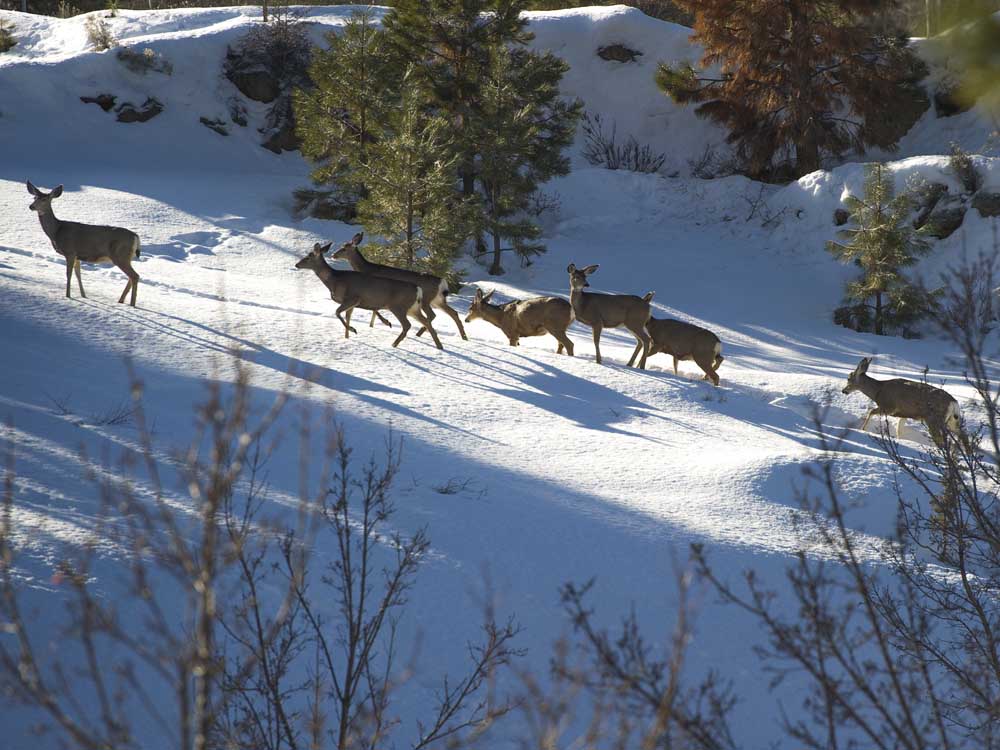Central Oregon wildlife know what they’re doing in winter
Published 11:56 pm Tuesday, January 24, 2017

- A small herd of deer makes its way through a vacant lot in Bend while foraging for food Monday. (Ryan Brennecke/Bulletin photo)
Of all of the winter-survival skills that Central Oregon’s creatures use, turkey vultures may display the best.
They head to South America for a few months.
“That’s one way the vultures survive the winter. They leave,” Matthew Orr, an Oregon State University-Cascades biology professor, said of the birds’ trips to the southern U.S. and into Central and South America. “They’ve got their retirement package.”
While it’s assumed they go to avoid the cold weather, they also just may not be the best competitors for the carcasses that suddenly become a desirable meal option for other birds and animals that grow more desperate for food in winter months.
Some deer — running on energy and fat reserves as food grows scarce — don’t survive rough winters and their carcasses then wind up feeding other animals, including ravens and eagles that must get enough food to maintain the metabolic heat that keeps them warm.
“A lot of what they’re feeding on is animals that can’t make it through the winter,” Orr said.
Ravens and eagles tend to help each other out a bit, with eagles using ravens to help locate dead animal meals and ravens relying on eagles to break open the skin of carcasses so they can start eating. The resourceful, omnivorous ravens are smart about finding food in winter, and Orr recalled an author’s description of the bird’s eating habits: “They’ll eat anything from a worm to a whale” that washes up on a beach.
Golden eagles live here year-round, and ravens can live in northern Canada and survive cold winters just fine.
“Staying warm does not appear to be a problem for them,” Orr said. “They do the same thing we do, which is to get under a bunch of down.”
At the High Desert Museum, the public often wants to know how animals deal with the cold, especially the birds that mostly stay outside in their birds of prey exhibit. But they have shelter and choose to stay outside, said Jon Nelson, curator of wildlife at the museum.
“They deal with the cold just fine,” Nelson said, noting how birds are able to capture air beneath their feathers that warms up and insulates them.
He pointed to the Swainson’s hawk that would normally migrate to South America for winter but lives at the museum.
“She is perfectly fine sitting on a perch in single-digit weather,” he said.
The museum’s two badgers, on the other hand, go into torpor, a semi-hibernating state of lethargy when they slow way down.
“They’re just very sleepy and fat,” Nelson said.
Porcupines take a similar approach.
The area’s reptiles would normally dig into the ground or find some other safe, covered spot and go into a sort of hibernating state. But at the museum, their exhibit remains about 80 degrees.
The museum’s otters, with their dense fur and layers of fat, appear impervious to the cold. They break up ice on the water in their area so they can go for a swim.
“And then they use the floating pieces as play toys,” Nelson said. “They’re having a ball.”
Other animals in the region have their own tactics. Bears go into a state of hibernation after bulking up so they can rely on fat reserves. The Sierra Nevada red fox grows a dense, thick winter coat and stays active all winter. Mountain lions and wolves also stay active, hunting and following deer. Bobcats and mountain lions tend to scavenge more through winter, likely because it’s easier and saves their own energy to just eat carrion rather than chasing down prey. Research using deer carcasses shows an increase in those animals eating — and sometimes fighting over — carcasses during cold weather.
American pikas do not hibernate but hang out in their dens through winter with the food they’ve stored, wearing thick coats to help keep warm. The small, mouselike mammal, a rabbit relative, lives in high elevations in Canada and the Western U.S., including in the Cascades, and cannot withstand temperatures over about 78 degrees.
Some animals cache food, but that can be hard to find with deep or compacted snow, noted Sara Gregory, a wildlife habitat biologist with Oregon Department of Fish and Wildlife. Some take what they can get. Rodents may resort to eating tree bark.
“Most animals try to bulk up in spring and summer,” Gregory said of herbivores that then try to just survive winter.
Gregory urged people to leave animals alone so they can conserve energy, noting the reason for road closures and winter range for deer that aim to reduce the disturbances and stress for the region’s wildlife through winter. Animals may also use cleared roads and other paths of least resistance more often as they look to save energy while moving through snowy terrain.
“Everybody’s kind of going on reserves this time of year,” she said.
But the region’s critters know how to make it through.
“They know what they’re doing better than we do,” Orr said.
— Reporter: 541-617-7812, hcorrigan@bendbulletin.com






